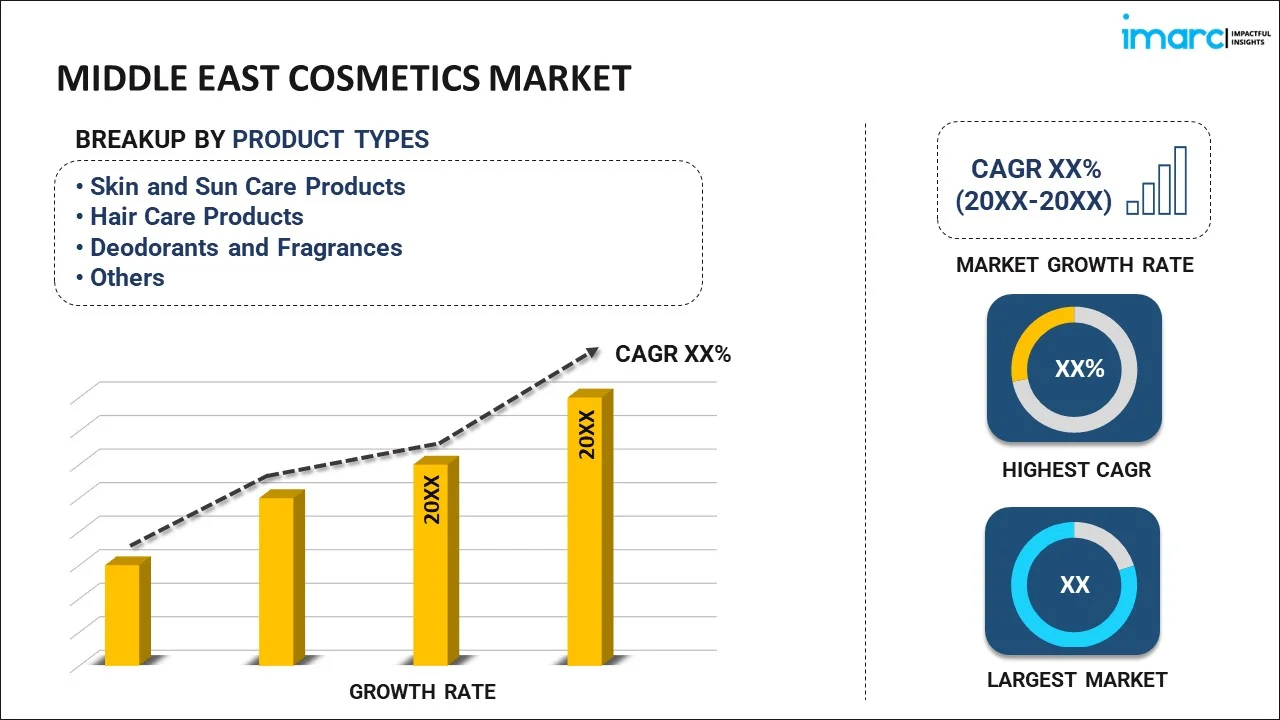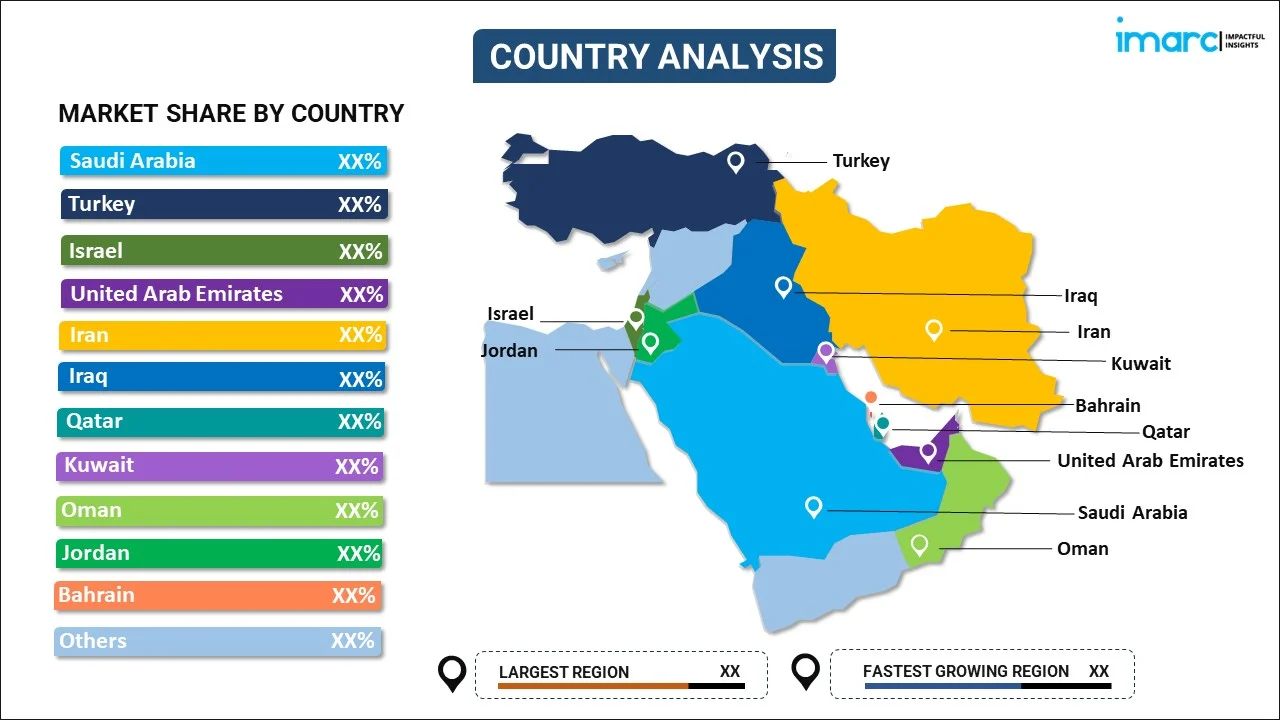
Middle East Cosmetics Market Report by Product Type (Skin and Sun Care Products, Hair Care Products, Deodorants and Fragrances, Makeup and Color Cosmetics, and Others), Category (Conventional, Organic), Gender (Men, Women, Unisex), Distribution Channel (Supermarkets and Hypermarkets, Specialty Stores, Pharmacies, Online Stores, and Others), and Country 2024-2032
Middle East Cosmetics Market Size:
The Middle East cosmetics market size is projected to exhibit a growth rate (CAGR) of 3.70% during 2024-2032. The market is being driven by the increasing awareness regarding personal grooming, rising consumer disposable incomes, a growing preference for organic and natural products, and the implementation of favorable policies by governments across the region.
|
Report Attribute
|
Key Statistics
|
|---|---|
|
Base Year
|
2023 |
|
Forecast Years
|
2024-2032
|
|
Historical Years
|
2018-2023
|
| Market Growth Rate (2024-2032) | 3.70% |
Middle East Cosmetics Market Analysis:
- Major Market Drivers: The increasing disposable incomes of the individuals and the rising demand for natural beauty products are some of the major market drivers. Additionally, the expanding influence of social media and beauty influencers in the region significantly promotes the adoption of new cosmetic products.
- Key Market Trends: The rapid growth in e-commerce has enabled easier access and distribution of cosmetic products, which is a key market trend. The shift towards halal cosmetics and the emergence of niche segments are also among the major market trends fueling cosmetics demand in Middle East.
- Competitive Landscape: Some of the major market players in the Middle East cosmetics industry include Avon Products Inc, Beiersdorf, Kao Corporation, and L'Oréal S.A, among many others.
- Challenges and Opportunities: The intense competition from local and international brands is a challenge. The opportunities lie in the increasing adoption of digital marketing and the innovations in product formulations.
Middle East Cosmetics Market Trends:
Advent of AI/AR-based beauty applications
Key market players are launching AI/AR technology-based beauty applications to educate consumers about their skin and beauty care profiles. These innovative applications utilize real-time skin analysis and virtual product trials to personalize recommendations, enhancing user engagement and satisfaction. Moreover, such technologies help brands gather valuable consumer data, enabling them to tailor their marketing strategies more effectively. For instance, Shiseido Co. Ltd., a Japanese cosmetics company, developed a digital application named Beauty AR Navigation that educates users on their facial skin health profiles. It makes cosmetic product recommendations to users, allowing them to establish a good skincare routine. The introduction of such AI/AR-based skincare-related mobile beauty applications is projected to bolster the Middle East cosmetics market share.
Rising awareness regarding health, hygiene, and grooming
The increasing awareness regarding health, hygiene, and grooming concerns is expected to fuel the product demand across the region. Beauty products can improve the quality, cleanse, and beautify external body parts and thereby assist individuals look healthier and more attractive. Therefore, these are some of the factors that have resulted in increasing product demand among younger and aged populations. The rising trend of using sun care products, night skin repair creams, fragrances, hair colors, and others, is also expected to bolster the product demand during the Middle East cosmetics market forecast period. Furthermore, the growing prevalence of digital marketing and social media influence has played a crucial role in shaping consumer perceptions and buying behaviors in the region. Beauty brands are increasingly leveraging online platforms to reach a wider audience, offering extensive information and reviews that help consumers make informed choices. This digital shift not only drives product demand but also fosters a more informed and health-conscious consumer base. As a result, the Middle East cosmetics market is witnessing a transformation, characterized by a growth in demand for products that align with global health and beauty standards. These developments provide valuable Middle East cosmetics market insights, highlighting the dynamic changes and opportunities within this sector.
Growing efforts by market players
The Middle East cosmetics market is dominated by established players that have a significant market share and robust manufacturing capabilities. These firms have extensive distribution networks and good relationships with customers. Innovation, product launches, brand debuts, and collection expansions help increase consumer interest, meet changing trends, and sustain brand relevance. These strategies enable businesses to meet various consumer needs, remain competitive, and capitalize on market fluctuations, assuring long-term success and client loyalty. According to the Middle East cosmetics market report, the increasing efforts and initiatives undertaken by the market players are favoring the market growth.
Middle East Cosmetics Market Segmentation:
IMARC Group provides an analysis of the key trends in each segment of the market, along with forecasts at the regional and country levels for 2024-2032. Our report has categorized the market based on product type, category, gender, and distribution channel.
Breakup by Product Type:

- Skin and Sun Care Products
- Hair Care Products
- Deodorants and Fragrances
- Makeup and Color Cosmetics
- Others
The report has provided a detailed breakup and analysis of the market based on the product type. This includes skin and sun care products, hair care products, deodorants and fragrances, makeup and color cosmetics, and others.
Breakup by Category:
- Conventional
- Organic
A detailed breakup and analysis of the market based on the category have also been provided in the report. This includes conventional and organic.
Breakup by Gender:
- Men
- Women
- Unisex
The report has provided a detailed breakup and analysis of the market based on gender. This includes men, women, and unisex.
Breakup by Distribution Channel:
- Supermarkets and Hypermarkets
- Specialty Stores
- Pharmacies
- Online Stores
- Others
A detailed breakup and analysis of the market based on the distribution channel have also been provided in the report. This includes supermarkets and hypermarkets, specialty stores, pharmacies, online stores, and others.
Breakup by Country:

- Saudi Arabia
- Turkey
- Israel
- United Arab Emirates
- Iran
- Iraq
- Qatar
- Kuwait
- Oman
- Jordan
- Bahrain
- Others
The report has also provided a comprehensive analysis of all the major markets in the region, which include Saudi Arabia, Turkey, Israel, United Arab Emirates, Iran, Iraq, Qatar, Kuwait, Oman, Jordan, Bahrain, and Others.
Competitive Landscape:
- The market research report has also provided a comprehensive analysis of the competitive landscape in the market. Detailed profiles of all major companies have been provided. Some of the major market players in the Middle East cosmetics industry include Avon Products Inc, Beiersdorf, Kao Corporation, L'Oréal S.A, and Türk Henkel Kimya Sanayi ve Ticaret A.Ş., among many others.
(Please note that this is only a partial list of the key players, and the complete list is provided in the report.)
- The market includes both established global companies and emerging players, whose presence bolsters the Middle East cosmetics market growth. Key industry players in the Middle East prioritize rapid product innovation, differentiation, and distinctive product designs in line with changing consumer preferences. These key players also reach diverse consumer bases and tap into developing markets. Some of the key market players are also investing heavily in other companies. For instance, in January 2024, the L'Oreal Group's venture capital arm, BOLD (Business Opportunities for L'Oreal Development), announced an investment in Timeline, a consumer health startup. This, in turn, creates a positive Middle East cosmetics market outlook.
Middle East Cosmetics Market News:
- September 21, 2023: Avon Products Inc. introduced the latest fragrance, Far Away Beyond The Moon. The floral oriental perfume is gentle, creamy, and hypnotizing, with rich balsamic milky notes. The Belle de Nuit note was made without damaging the natural environment after being sustainably captured from the Hawaiian island of Kauai using headspace technology that does not involve flower picking.
- April 23, 2024: Beiersdorf entered into a multi-year strategic partnership with Rubedo Life Science to develop a breakthrough anti-aging solution for the global face care market. This partnership shows a fusion of Beiersdorf’s leadership in skin care innovation with Rubedo’s complementary expertise in targeting cellular senescence.
- April 26, 2024: Kao Corporation announced that it will launch LUNAFLOW RA, a mold release agent for use in smoothly removing rubber and resin products from molds during manufacture, in May 2024. LUNAFLOW RA is manufactured using cellulose nanofibers (CNF), a cutting-edge biomass material, and offers superior demolding performance and durability for repeated use once applied.
Middle East Cosmetics Market Report Scope:
| Report Features | Details |
|---|---|
| Base Year of the Analysis | 2023 |
| Historical Period | 2018-2023 |
| Forecast Period | 2024-2032 |
| Units | US$ Million |
| Scope of the Report | Exploration of Historical Trends and Market Outlook, Industry Catalysts and Challenges, Segment-Wise Historical and Future Market Assessment:
|
| Product Types Covered | Skin and Sun Care Products, Hair Care Products, Deodorants and Fragrances, Makeup and Color Cosmetics, Others |
| Categories Covered | Conventional, Organic |
| Genders Covered | Men, Women, Unisex |
| Distribution Channels Covered | Supermarkets and Hypermarkets, Specialty Stores, Pharmacies, Online Stores, Others |
| Countries Covered | Saudi Arabia, Turkey, Israel, United Arab Emirates, Iran, Iraq, Qatar, Kuwait, Oman, Jordan, Bahrain, Others |
| Companies Covered | Avon Products Inc, Beiersdorf, Kao Corporation, L'Oréal S.A, Türk Henkel Kimya Sanayi ve Ticaret A.Ş., etc. |
| Customization Scope | 10% Free Customization |
| Report Price and Purchase Option | Single User License: US$ 3699 Five User License: US$ 4699 Corporate License: US$ 5699 |
| Post-Sale Analyst Support | 10-12 Weeks |
| Delivery Format | PDF and Excel through Email (We can also provide the editable version of the report in PPT/Word format on special request) |
Key Questions Answered in This Report:
- How has the Middle East cosmetics market performed so far, and how will it perform in the coming years?
- What has been the impact of COVID-19 on the Middle East cosmetics market?
- What is the breakup of the Middle East cosmetics market on the basis of product type?
- What is the breakup of the Middle East cosmetics market on the basis of category?
- What is the breakup of the Middle East cosmetics market on the basis of gender?
- What is the breakup of the Middle East cosmetics market on the basis of distribution channel?
- What are the various stages in the value chain of the Middle East cosmetics market?
- What are the key driving factors and challenges in the Middle East cosmetics market?
- What is the structure of the Middle East cosmetics market, and who are the key players?
- What is the degree of competition in the Middle East cosmetics market?
Key Benefits for Stakeholders:
- IMARC’s industry report offers a comprehensive quantitative analysis of various market segments, historical and current market trends, market forecasts, and dynamics of the Middle East cosmetics market from 2018-2032.
- The research report provides the latest information on the market drivers, challenges, and opportunities in the Middle East cosmetics market.
- The study maps the leading, as well as the fastest-growing, markets. It further enables stakeholders to identify the key country-level markets within the region.
- Porter's five forces analysis assists stakeholders in assessing the impact of new entrants, competitive rivalry, supplier power, buyer power, and the threat of substitution. It helps stakeholders to analyze the level of competition within the Middle East cosmetics industry and its attractiveness.
- The competitive landscape allows stakeholders to understand their competitive environment and provides an insight into the current positions of key players in the market.
Need more help?
- Speak to our experienced analysts for insights on the current market scenarios.
- Include additional segments and countries to customize the report as per your requirement.
- Gain an unparalleled competitive advantage in your domain by understanding how to utilize the report and positively impacting your operations and revenue.
- For further assistance, please connect with our analysts.
 Inquire Before Buying
Inquire Before Buying
 Speak to an Analyst
Speak to an Analyst
 Request Brochure
Request Brochure
 Request Customization
Request Customization




.webp)




.webp)












